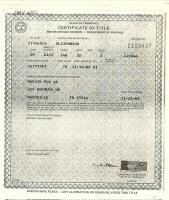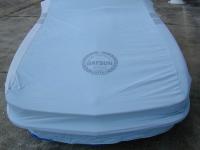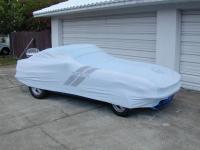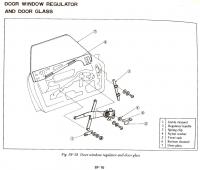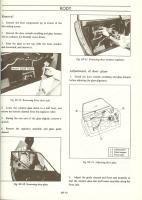Everything posted by Carl Beck
-
Garage Floors
Hi Fred: The floor looks great - now that you have the experience, the next time you are down, we can do mine. We used that product on the showroom floors at the Datsun Dealership - and on the warehouse floors at Base Supply on the base. Very durable stuff.... a little slippery when wet.... but very easy to clean up... Carl B.
-
hls 51 for sale
and Hi Montezuma / Stephen (everyone): #51 is actually both a 70 and a 69. It's a 1969 Production Year.. and/or a 1970 "Model Year". It would be referred to as a 1969 "Production Year" example; to distinguish it from the rest of the 240-Z's produced during Calendar Year 1970. To collectors, the limited number of Datsun 240-Z's that were produced in Oct., Nov. and Dec. of 1969; carry a higher value than the 240-Z's produced in 1970 for a couple main reasons. First, there were a very limited number produced in 1969 - so they are far more rare to see today. Secondly because they were produced at the very beginning of the production run, several detailed aspects of them add interesting tid-bits of trivia to their rarity. Nissan intended them to be one of their 1970 "Model Year" Line-up. So in most cases Nissan's Authorized Dealers sold them and titled them as such. However, because of previous practices from the 50's and 60's - when Foreign Car Manufacturers held their Model Year vehicles concurrent with the Calendar Year - a few Datsuns were still being sold and titled in various States, based on their Production Year..... ie... a 240-Z produced in 1969 could have would have been sold and titled by the Authorized Dealer as a 1969 Model Datsun 240-Z, based on the Manufacturers Statement Of Origin {MSO} . - See the title for HLS30 00020 below for an example. I understand from some of the forum members here - that in Australia cars were always advertised, sold and titled based on the calendar year in which they were first sold, regardless of production year or model designations given by the manufacturers. With the introduction of U.S. Federal Legislation related to Safety Standards and Emission Controls for automobiles in 1967, the automobile manufacturers, that sold automobiles in the U.S. all "started" to align the release and sale of their new models to a more standard set of dates. That was because the way the Federal Laws were written, required Safety and Emissions Standards were implemented, and were to be complied with by specific calendar dates. So we see that in the USA: The Series I 240-Z's started regular production in Oct. of 69 (Sold as 69, 70 and 71 Model Years) The Series II 240-Z's started regular production in Jan. of 71 (Sold as 1971 Model Year) The Series III 240-Z's started regular production in Sept. of 71 (Sold as 1972 Model Year) The Series IV 240-Z's started regular production in Aug. of 72 (Sold as 1973 Model Year) The 260-Z's started regular production in Aug. of 73 (Sold as 1974 Model Year) The 280-Z's started regular production in Dec. of 74...... Regular production was delayed because of a shortage of the necessary F.I. Parts, and delays in getting the 280-Z certified by the U.S. Federal Government for sale in the U.S. FWIW, Carl B.
-
hls 51 for sale
Charile sold it to Steve - and today a man named Robert.... owns it. Never received the new owners name and info - so the old listing is still on the Register... FWIW, Carl B.
-
Z Experts - Arne, Marty, Carl - This one is for you....
Hi Bo: Boy - you have me on that one. I have no idea of the specific type or composition of the material used... When new they would have been described as a synthetic rubber of some type - like that used in tire treads.. it was pretty firm stuff.... If I were going to market them - first I would sell them in compete sets ONLY and include every one used in the car... second I'd do the sets for the 510's and Pick-up's.... (most likely many of the same parts..). But they would have to look identical to the originals... Personally, I'd rather go to China and reproduce the 73-78 GMC Motor Homes - only with a modern drive train... Good luck with the project... I'd be a buyer... Carl B.
-
25 x 25 garage / 2-post lift & garage door placement?
Hi Gary: 1. Is there some reason you must use a 25'x25' layout? 2. Is this a secondary garage to work on your car only - or your only garage that must be shared with other vehicles? 3. What size garage door do you have in mind? A standard 8'x16' " or......... 4. What construction type are you planing on using? Wood Frame, Steel, Block??? In general I agree with 240ZX - just use a Roll-up door, instead of the more typical Sectional Garage Door. The Roll-up Garage Doors seal more completely to the garage door opening in the building - so insulated or not they would most likely provide beater heat retention/ cold rejection in the Winter.. A 12' ceiling height is plenty for the use of a lift for a Z - the typical lift only raises the bottom of the tires about 6' off the floor - and the Z is what? around 4 1/2' tall... so even with the hood partly open you shouldn't have any issues..... The only problem with scissor type trusses is they eliminate over-head storage space. If I had it to over - I'd make a garage at least 30' deep - that way you can park two First Generation Z's in there end to end in ony bay - three if you put one on the lift.... But more importantly - you have room at each end of the car to get around the car easily and still have room for things like work benches, tool boxes, compressors etc. at the ends of the car. 25x25= 625 sq. ft and so a 21x30 would also provide about the same total in a more work friendly layout... FWIW, Carl B.
-
What size engine stand?
Rolling Stability is the main consideration - I like the type of engine stands that I can store when not in use. This is an example, but there are many others.. Also an oil drip pan, that sits across the front legs - saves a lot of clean up. <a href=http://www.harborfreight.com/cpi/ctaf/Displayitem.taf?itemnumber=47304 TARGET=NEW> 2000 LBS. Capacity<a/> Buy two of them at the same time - and later you can use them for a rotisserie for the body shell. From time to time our local Sam's Club has 2000 or 3000lb. engine stands of the same type for around $59.00 each.. FWIW, Carl B.
-
Nissan discontinued the B6ES Plugs for the 280Z's
The extended tip plugs are designed to keep the tip of the plug {electrodes} farther into the flame ball in the combustion chambers - so that it helps prevent carbon fouling and provides a more uniform burn. With the use of Fuel Injection and electronic ignitions - the extended tip was no longer required because the F.I. system provides a far more accurate fuel/air mixture, far more constantly and the E.I. provides a better spark anyway. Nonetheless - there would be no harm runing either one in a 280Z. The "6" indicates the heat range of the plug - so other than keeping the electrodes in the tip hotter - there is no difference in the plugs ability to absorb and dissipate heat. FWIW, Carl B.
-
BRE 240Z Medallions
Hi Goose52: Thanks - it has been an amazing cover. Wish someone make them today exactally the same way. I don't know how many times it's been washed over the years, and it has faded a little bit - but otherwise it's still like new. As I recall it was about $49.95 back in 71.. We just bought a new washer/dryer - to replace our 20 year old set - that finally gave out. The only criteria for the new washer was that it had to be big enough to wash my car cover. FWIW, Carl B.
-
1972 vs 1973 240z specifications
Hi Guys: One thing is for sure - the 73 Model Year 240-Z's for the US had VIN's starting with HLS30 120001. Bob Bondurant's 240-Z has a VIN of HLS30 1200031 and a build date of 08/72. HLS30 120596 however has a 09/72 build date.. and HLS30 123849 has a build date of 10/72. FWIW, Carl B.
-
1972 vs 1973 240z specifications
For the 73 Model Year Production of the 73 Model Year 240-Z for the US and Canada started in 08 of 72. - Carb.'s changed (as mentioned) - different E-88 Head Used For Federal Emissions Std.'s in 73. - Dash layout changed, with backlight heater/vent controls, - new hazzard switch design. - Headlight buckets changed from fiberglass to steel. - Flame retardent materials were required for interior use. - Intermitten windshield wipers added as standard equipment. - Two and a half mile per hour bumpers added. - The rods were the same - but larger connecting rod bolts were used. 8mm vs 9mm This actually started at the 2/3's of the way through the 72 Model Year Starting at Engine Serial Number: L24-096181 That would be in US/Canada 240-Z's with a build date starting in 04 of 72. FWIW, Carl B.
-
BRE 240Z Medallions
Hi Chris / Goose52 everyone: I agree - the Ad. lines during the transition from BRE to INTERPART, put out by BRE was "Now We Are INTERPART".. and to everyone's mind the BRE Parts Business was INTERPART and vis versa. BRE stuff was BRE stuff no matter if you bought it from BRE or later INTERPART. As Chris correctly pointed out - MULHOLLAND stuff was not BRE stuff... INTERPART was started so that the BRE Shop could focus on racing and not spend so much time shipping BRE Parts. I'd have to check with Mr. Brock, but I believe that when InterPart was first formed, Mr. Brock held a 30% or 40% interest in Interpart, and his primary interest was to continue the BRE Parts Sales (and associated income).. while off loading the Parts Business work - from the Racing Shop. In the original agreement between Nissan and BRE, the Nissan Authorized Dealers would sell BRE Parts via their Datsun Parts Dept.'s and BRE could market Nissan Competition Parts via BRE. BRE for example sold a slightly re-designed Nissan Rear Spoiler, that was fabricated locally for BRE. BRE's Competition Oil Pump Springs - were another example of Nissan Parts re-branded and sold as BRE parts. As the InterPart business grew - it required more employees, more investment in inventory, and more capital to have additional items produced so they could be added to the line up - like the BRE Headlight Covers, BRE Car Covers etc. So additional investments were made by the other partners and Mr. Brocks' ownership in terms of the percentage of the business was diluted to much less than the original 30% or 40%.... Also BRE shut down around the end of 1973 or in early 1974.... Any business needs growth - and the Mulholland Brand started to fill that need for growth..as well as things like the Shadow Shade Kits etc. BTW - My BRE Z Car Cover, purchased before Dec. of 71 - does have the same commemorative wreath that Goose52 has on his Bra.. I think I still have the same BRE Bra somewhere out in the garage as well. I know I purchased the car cover before the end of Dec. 71 - because I had to park my 240-Z in the hangers at the Air Base and I wanted it covered, as I was TDY to SEA. FWIW, Carl B.
-
BRE 240Z Medallions
Hi Wayne: 137 Oregon was the BRE Shop/Parts 141 Oregon was the first Interpart Building 100 Oregon was the second Interpart Building So the fire must have been 2/72 and 8/72.... FWIW, Carl B.
-
Passenger side door window..See photos
-
another question.... starters?
...... because the starter engages the Ring Gear on the Flywheel - has nothing to do with whatever standard transmission you have. FWIW, Carl B.
-
BRE 240Z Medallions
Hi Goose52: I was thinking that by 72 - the Parts Counter would have been at Interpart. At any rate - the original run of 510 Badges and Medallons were lost when the Interpart shop burned... and they moved to a newer location and reopened. I'm thinking that was around 74 or so... You wouldn't happen to have any pictures of the original BRE Shop would you? Carl B.
-
Roof racks for a Z
Hi Mike: Yes - that's the one. I think it's the same seller I bought mine from too. There was also an accessory that converted or utilized the Roof Rack as a Ski Rack. Carl B.
-
BRE 510 on Ebay ?
Hi Guys: First let me say that I believe any DATSUN 510 with a documented 7K original miles and a rust free body is worth at least the current bid and perhaps far more... I haven't seen a 510 on the streets here in Florida for at least the last ten years... and I know there are tens of thousands of people that love the 510's. I believe that Mr. Brock even owns a 510 today.(being highly mod'ed out). Reviewing what Mr. Kohs has written - When Mr. Kohs refers to "we" - I get the distinct impression that at the time and today - he feels he was part of the over-all NISSAN/ DATSUN BRE team. It would seem that "The Marketing Corporation of America" worked for NISSAN/DATSUN USA and with the BRE Team as well as with the DATSUN Competition Dept. Ron reports that Gary did "some work promoting BRE" - - My understanding is that Gary Kohs (Marketing Corporation of America) acquired the SIMONIZ sponsorship for BRE, got Revell to do a promotional model of the BRE 510 and associated advertising etc. plus a lot more {as Gary states in his E-Bay write-up}. So his involvement was more on the major side of things, than a minor bit player....(money is a very important part of racing and Marketing is the primary driver for sponsorships). He also stayed with NISSAN/DATSUN after BRE folded... and kept the SIMONIZE sponsorship for Jim Conner's successful campaign of the Datsun Pick-up's, prepared by Bill Stroppe, at the Baja. (June 74 Issue of the DATSUN NEWS). Given Mr. Brocks conflicts with the people at Datsun Competition I can understand his displeasure with Mr. Kohs. It will be interesting to see if Mr. Kohs comes up with invoices for work done on the car at BRE. He said they installed a 5spd, race suspension, mild engine mod.'s and American Mags..etc. The bottom line is - the seller has more than sufficient documentation to prove his, and this 510's ,"association" (good or bad) with both Nissan/DATSUN USA and BRE... Failed project or not... it's part of the history associated with the over-all story. So I would think that any serious BRE collector would place some premium, over and above the value of most other regular production 510's - on this one. Just my perspective... but a lot of the value of any collector car is found in it's documented history and the interesting stories surrounding them. FWIW, Carl B.
-
Vin
Hi Jerry/Arne: Arne is correct - VIN's between HLS30 91591 and 95904 were all built 07/72. Your original engine serial number - from the Data Plate under the hood - should be between L24-113xxx and L24-120xxx. You can order a new VIN Plate for the Drivers Door Jam from <a href=http://www.zzxdatsun.com TARGET=NEW>Banzai Motorworks </a> FWIW, Carl B.
-
long and short pig tail fuse boxes..whats the dif?
Hi Arne: It would seem to be so... The good news was they were now switching the power.... but the bad news was they were still running the full power though the switch... instead of using the switch to toggle a relay. Even that wouldn't have been so bad - if it was only the headlight switch... but the Combination Switch was complex and EXPENSIVE... not to mention the Fuse Box itself destine to melt down...
-
long and short pig tail fuse boxes..whats the dif?
According to the Service Bulletin - for the Series II Datsun 240-Z on US and Canada cars. - - - quote - -- - The head lamp harness has been changed from the previous design. The dual system circuit now includes a battery switch in place of the former ground switch to prevent electro-chemical attachment on the lamp terminals while the switch is left "OFF". In accordance with this improvement, the head lamp cover has been eliminated on USA and Canada models. Affected Changes Fuse block ...... Internal connection changed (one lead wire added to harness) Light Switch.... One lead wire added to harness Harness.... Instrument and heater circuits changed Combination switch Head lamp and wiper - ground circuits have been separated. As the result, one lead wire has been added to the harness. - - - end quote - - - - Looking at the schematics..... For the Series II cars - there is one additional Red Wire running between the fuse block and the combination switch. All other connections and fuses are the same. So it would seem that you can use the newer fuse block - in the older cars.... but you couldn't use the older fuse block in the newer cars. FWIW, Carl B.
-
long and short pig tail fuse boxes..whats the dif?
Hi Chris (everyone): My Parts Fiche shows: 25410-E4600 Assy Fuse Block "Up-To" 12/70 25410-E8300 Assy Fuse Block "From" 01/71 25410-E8800 Assy Fuse Block "Up-To" 07/73 As I understand it - that means that the E8300 number could have been superceded at any point between 01/71 and 07/73 by the E8800 number. {"Up To" gives you the end date - where "From" provides the start date} 25410-N3600 Assy Fuse Block "From" 08/73 Would mean that the E8800 number was replaced with N3600 starting as of 08/73. I don't show any E8600 number (25410-E8600) My Fiche is as Revised "December 1979".... FWIW, Carl B. Clearwater, FL
-
Pic request of Butterscotch Z's....... And our pix. Take a look!!!!!
HI Keith: Silver is one of my favorite colors on the 240-Z. It highlights the beautiful lines of car. If you and your Father are going to do a full color change - and a full "refresh" or even a full "restoration" on the Z - I'd paint it any of the original colors you want. While many have a point about retaining the Gold car in it's current "original" condition - I'm betting that upon close physical inspection, the original paint isn't all that great today... and it's really is time to replace it. Your Fathers Yellow 240-Z looks great... Good luck, Carl
-
Another nice yellow one on Ebay
Hello Everyone: The seller had to relist the car - corrected the VIN # listed and dropped the offer to take "trades" as e-bay doesn't allow trading.. Search for new Item number: 150105356624 FWIW, Carl B.
-
Another nice yellow one on Ebay
I have written the seller to inform him that the Florida DMV did indeed have a computer error induced during some transition of records from one system to another in the early 90's... So if it is a mistake, then the car is very reasonably priced at the Buy-it-Now for $8K - for this area of the country... (if it checks out otherwise) 1971, with 71K original miles, present and previous owners known... If it checks out under the car (frame rails and floorboards - area under the battery etc).... it would be a good buy for anyone that is looking for a nice driver. Better to pay an extra couple of grand - if the car is in your area and you can check it out completely before you buy - than to bid on a cheaper car located across the country... All the above said - it is still up to the seller to provide "good title" , unless the buyer agrees to accept the car with a Salvage/Rebuilt title... (which might be acceptable if the price was cut in half for example). Carl B.
-
engine oil selection
Red Line's Water Wetter is a surfactant with the necessary anti-corrosives and water pump lubricants found in permanent Summer Coolants/Anti-Freeze. A surfactant breaks down the surface tension of a liquid and thus allows the molecules of the water to come into closer contact with the metal surfaces over which it is flowing. In turn this allows the water to pick up more heat from the engine, and it allows the water to pass off more heat when in the radiator. Most major automotive parts stores carry it today.. FWIW, Carl B.




